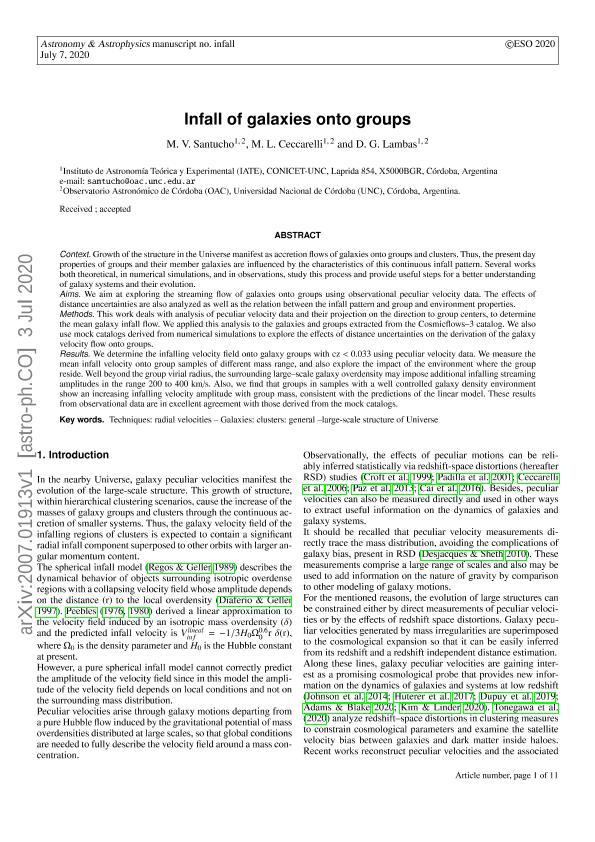Mostrar el registro sencillo del ítem
dc.contributor.author
Santucho, María Victoria

dc.contributor.author
Ceccarelli, Maria Laura

dc.contributor.author
Garcia Lambas, Diego Rodolfo

dc.date.available
2021-04-20T18:30:04Z
dc.date.issued
2020-10
dc.identifier.citation
Santucho, María Victoria; Ceccarelli, Maria Laura; Garcia Lambas, Diego Rodolfo; Infall of galaxies onto groups; EDP Sciences; Astronomy and Astrophysics; 642; A131; 10-2020; 1-11
dc.identifier.issn
0004-6361
dc.identifier.uri
http://hdl.handle.net/11336/130518
dc.description.abstract
The growth of the structure within the Universe manifests in the form of accretion flows of galaxies onto groups and clusters. Thus, the present-day properties of groups and their member galaxies are influenced by the characteristics of this continuous infall pattern. Several works both theoretical (in numerical simulations) and observational, have studied this process and provided useful steps for a better understanding of galaxy systems and their evolution. Aims. We aim to explore the streaming flow of galaxies onto groups using observational peculiar velocity data. The effects of distance uncertainties are also analyzed, as well as the relation between the infall pattern and the group and environment properties. Methods. This work deals with the analysis of peculiar velocity data and their projection in the direction of group centers, in order to determine the mean galaxy infall flow. We applied this analysis to the galaxies and groups extracted from the Cosmicflows-3 catalog. We also used mock catalogs derived from numerical simulations to explore the effects of distance uncertainties on the derivation of the galaxy velocity flow onto groups. Results. We determine the infalling velocity field onto galaxy groups with cz < 0.033 using peculiar velocity data. We measured the mean infall velocity onto group samples of different mass ranges, and also explored the impact of the environment where the group resides. Far beyond the group virial radius, the surrounding large-scale galaxy overdensity may impose additional infalling streaming amplitudes in the range of 200-400 km s-1. Also, we find that groups in samples with a well-controlled galaxy density environment show an infalling velocity amplitude that increases with group mass, consistent with the predictions of the linear model. These results from observational data are in excellent agreement with those derived from the mock catalogs.
dc.format
application/pdf
dc.language.iso
eng
dc.publisher
EDP Sciences

dc.rights
info:eu-repo/semantics/openAccess
dc.rights.uri
https://creativecommons.org/licenses/by-nc-sa/2.5/ar/
dc.subject
GALAXIES: CLUSTERS: GENERAL
dc.subject
LARGE-SCALE STRUCTURE OF UNIVERSE
dc.subject
TECHNIQUES: RADIAL VELOCITIES
dc.subject.classification
Astronomía

dc.subject.classification
Ciencias Físicas

dc.subject.classification
CIENCIAS NATURALES Y EXACTAS

dc.title
Infall of galaxies onto groups
dc.type
info:eu-repo/semantics/article
dc.type
info:ar-repo/semantics/artículo
dc.type
info:eu-repo/semantics/publishedVersion
dc.date.updated
2021-03-26T19:35:15Z
dc.journal.volume
642
dc.journal.number
A131
dc.journal.pagination
1-11
dc.journal.pais
Francia

dc.description.fil
Fil: Santucho, María Victoria. Observatorio Astronomico de la Universidad Nacional de Cordoba; Argentina. Consejo Nacional de Investigaciones Científicas y Técnicas. Centro Científico Tecnológico Conicet - Córdoba. Instituto de Astronomía Teórica y Experimental. Universidad Nacional de Córdoba. Observatorio Astronómico de Córdoba. Instituto de Astronomía Teórica y Experimental; Argentina
dc.description.fil
Fil: Ceccarelli, Maria Laura. Consejo Nacional de Investigaciones Científicas y Técnicas. Centro Científico Tecnológico Conicet - Córdoba. Instituto de Astronomía Teórica y Experimental. Universidad Nacional de Córdoba. Observatorio Astronómico de Córdoba. Instituto de Astronomía Teórica y Experimental; Argentina. Observatorio Astronomico de la Universidad Nacional de Cordoba; Argentina
dc.description.fil
Fil: Garcia Lambas, Diego Rodolfo. Observatorio Astronomico de la Universidad Nacional de Cordoba; Argentina. Consejo Nacional de Investigaciones Científicas y Técnicas. Centro Científico Tecnológico Conicet - Córdoba. Instituto de Astronomía Teórica y Experimental. Universidad Nacional de Córdoba. Observatorio Astronómico de Córdoba. Instituto de Astronomía Teórica y Experimental; Argentina
dc.journal.title
Astronomy and Astrophysics

dc.relation.alternativeid
info:eu-repo/semantics/altIdentifier/doi/http://dx.doi.org/10.1051/0004-6361/202038558
dc.relation.alternativeid
info:eu-repo/semantics/altIdentifier/url/https://www.aanda.org/articles/aa/abs/2020/10/aa38558-20/aa38558-20.html
Archivos asociados
